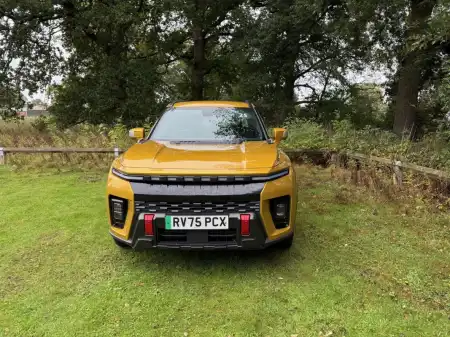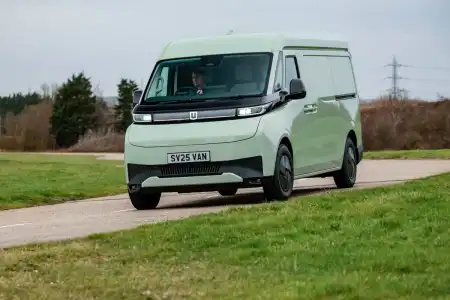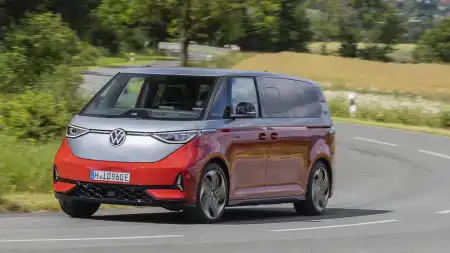- Impressive cargo volume and payload limit
- Ability to tow heavy trailers
- Tough, strong and reliable
- Very expensive
- Limited range
- Slow battery charging
Introduction
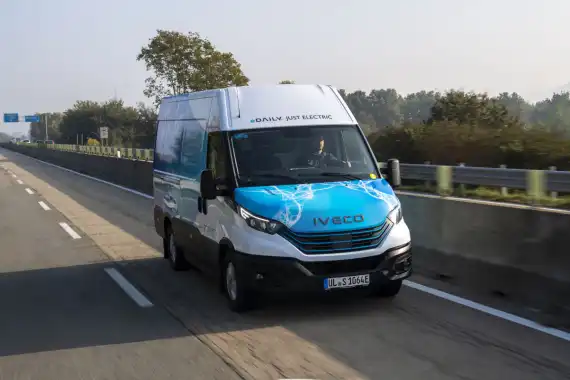
Let’s pretend the previous Iveco Daily Electric never existed, as the manufacturer’s first attempt at an electric van was both overpriced and underpowered. The new eDaily makes a much better fist of things, improving in every area.
There are a few clues that the eDaily is the electric version of the capable Daily van, but Iveco’s not shouting about it. The keen-eyed will spot new ‘IVECO’ text across the bonnet, while blue detailing around the van highlights its eco credentials.
What’s under the skin is very different, though. The heavy-duty truck chassis remains, but now there’s a modern electric drivetrain with a motor generating 190hp. It’s powered by battery packs mounted between the chassis rails, with buyers able to pick one, two or three of the 37kWh packs. The model we’re testing — a regular 3.5-tonne model with two battery packs — will run for 146 miles, according to WLTP testing. Iveco will also make a 4.25-tonne version available so businesses can take advantage of the government’s relaxation of category B driving licensing regulations. The range extends to a near-HGV 7.2-tonne gross weight.
Living With The Iveco E-Daily
While the eDaily is new, the regular diesel-powered model definitely isn’t, so don’t expect the most modern of cabins. Last facelifted in 2019, the thick-rimmed, slightly squared-off wheel sits in front of an instrument panel that’s half analogue, half digital. Buttons on the steering wheel control most functions on the small screen ahead of you, which displays helpful — including how much load you’ve got in the back of the van, which could come in very useful if you’re getting close to your payload limits.
The 7.0-inch infotainment screen in the dashboard's centre feels very small in a vehicle of this size. It handles nearly all other functions, including smartphone mirroring with Android Auto and Apple CarPlay, a DAB radio, and a navigation system that can route around width and height restrictions using a TomTom system.
There’s ample storage around the cabin, including twin boxes on top of the dashboard, a glovebox and under-seat storage. A section in the centre of the dashboard can be specified in different ways, with the A4 paper-sized slot and USB port in our van being a very sensible use of the space.
Driving an electric vehicle, whether it's a car or van, is inherently relaxing as you're freed from the noise, vibrations and shudders of an internal combustion engine, and that holds here, making for a harmonious and comfortable environment.
An electric motor provides peak power of 190hp and a torque figure of 400Nm, which is enough to handle city and motorway driving easily. However, the peak figures are only available in bursts of two minutes, with everyday driving limited to just 120hp and 220Nm of torque.
Still, even with half a tonne of cargo on board, the eDaily performed well, cruising at 70mph without issue. Throttle responses are near-instant when moving, although there's a significant pause before power is fed through from a standstill, which can cause some anxiety when pulling onto a busy road.
The steering is lifeless, with an odd dead area in the centre, with resistance increasing rapidly as you rotate the wheel beyond 30 degrees or so. A 'City' button increases steering assistance for easy manoeuvring in tight spaces, making it as easy to fling into a tight space as a Vauxhall Corsa.
Our eDaily had independent front suspension with the optional ‘Air-Pro’ pneumatic suspension at the rear, resulting in impressive ride quality, especially with the suspended driver's ‘comfort’ seat. It might be a bit bouncy when running empty, though.
Recharging the eDaily might be more time-consuming than you hope, as it’s limited to a rate of 80kW — some rapid chargers push out as much as 350kW of electricity at a time. Still, it will only take around 30 minutes to charge from 15% battery capacity to 80%. Plug in at home or a depot with a standard 7.4kW charger, and it’ll take just over 10 hours to charge from empty to full, although it's important to note that the battery is unlikely ever to be fully depleted.
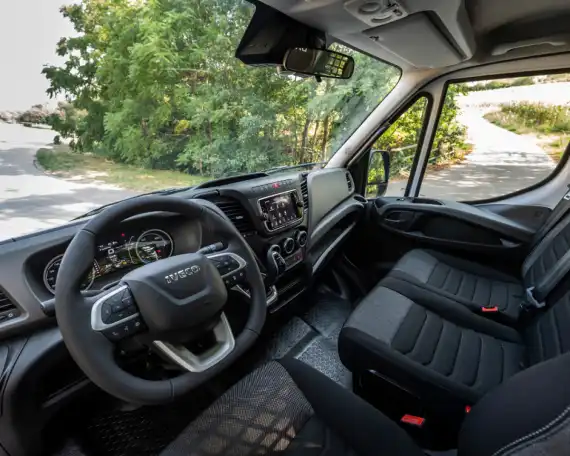
Space & Practicality
The eDaily’s van-like design belies its strong, ladder-frame chassis truck roots, but that means it can be specified with gross weights up to 7.2 tonnes and payloads of up to 4.6 tonnes or 20.3m3, and can still tow 3,500kg behind it. For moving heavy but relatively compact loads in the city, it’s unbeatable — the Ford E-Transit maxes out at just under 1.8 tonnes and 15.1m3.
At the other end of the scale, the 3.5-tonne models are more limited; our two-battery test van had a payload limit of just 920kg and 12.3m3 of cargo volume available.
There are over 200 variations to choose from, including five different body lengths and three roof heights, giving you a great chance of finding a suitable variant for your business.
Bodybuilders will also find it easy to convert this vehicle into almost anything a customer need, such as a refuse truck or a chiller box van suitable for supermarkets; the eDaily has three types of electric power take-off available, with outputs of up to 15kw, making it easy to operate tail lifts, refrigeration units, or pumps. Clever electronic systems in place allow you to continue working without affecting the main drive battery, too.
Ownership
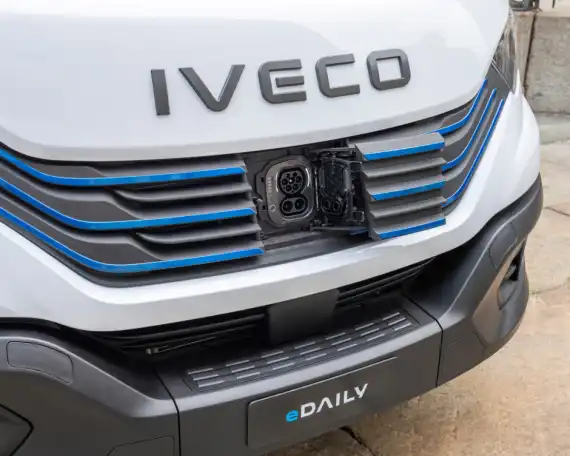
Running Costs
With electricity prices still at sky-high levels, the prospect of running an electric van can be daunting, but the maths might still work out for you. If you or your drivers can charge their vehicle at home, it’ll undercut a diesel equivalent by some margin, especially as some legacy tariffs still provide electricity at a rate of just 5p per kWh. That means a mid-range 74kWh battery pack would cost just £3.70 to charge completely, which will then be good for 146 miles. However, limit yourself to expensive motorway chargers, and that cost can ratchet up to more than £50.
The lesson? Ensure there’s suitable charging infrastructure at your home or depot. With a bit of planning, the fuel costs for the eDaily will be far lower than topping up with diesel.
Maintenance costs should be lower than the regular diesel Daily, aided by Iveco’s impressive active monitoring and support service. A dedicated ‘Customer Uptime’ centre monitors every van in real-time, providing proactive and predictive diagnosis to prevent downtime before it occurs. Even an owner-operator can access this service without needing a dedicated fleet manager.
Prices are expected to be relatively high for the eDaily — expect around £85,000 — which makes leasing deals look more attractive. That said, Iveco has cleverly tried to balance cost and battery capacity by allowing users to pick one, two or three battery 37kWh packs. While the 3.5-tonne model is limited to a maximum of two packs, giving 74kWh of power, the 4.25-tonne model can take all three (111kWh), extending its range to 186 miles.
Our test model, with two batteries and half a tonne of cargo on board, showed a range of 118 miles, although that was with some enthusiastic driving. A light right foot will improve on that.
Verdict
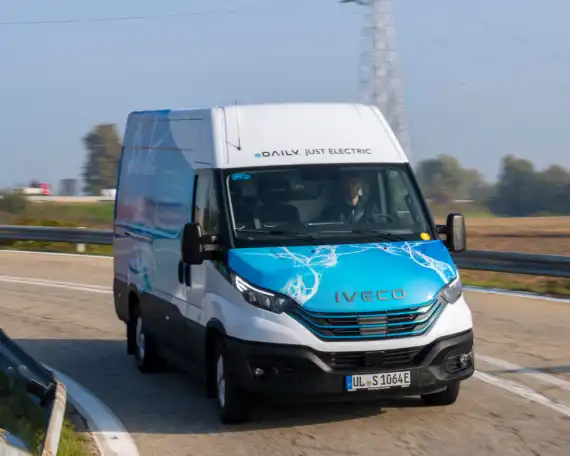
Reaching a definitive conclusion about the eDaily is tricky, as one business’s needs will vary hugely from another. That’s made more difficult by a lack of UK specifications, which means there’s a little bit of guesswork going on.
At the higher end of the eDaily range, the ability to carry 4.6 tonnes in the back, tow 3.5 tonnes, or squeeze in up to 20m3 of payload is compelling. It’s way ahead of its rivals, such as the Ford E-Transit, but then the eDaily is built around a truck chassis, giving it some of the heavy-duty abilities others lack. If you need something strong for a low-mileage duty cycle and are looking at conversions from tippers to waste disposal, then the eDaily is unrivalled.
However, that heavily engineered strength takes its toll at the lower level, where the 3.5-tonne model is somewhat more limited in payload and cargo volumes. For owner-operators or small businesses, that’s likely to be the most sought-after model, as licensing restrictions on drivers mean operating anything over that weight becomes more complex, and that’s where the van-based roots of the Ford E-Transit and rivals become more appealing.

